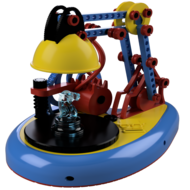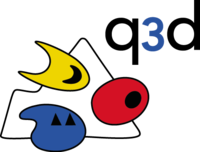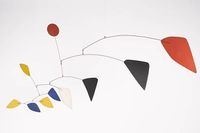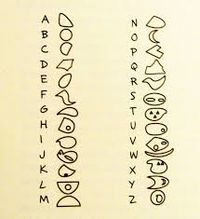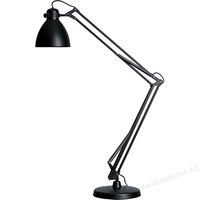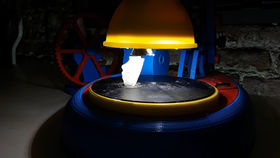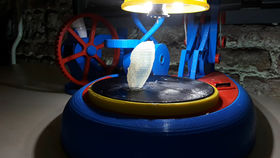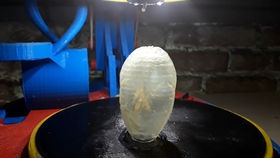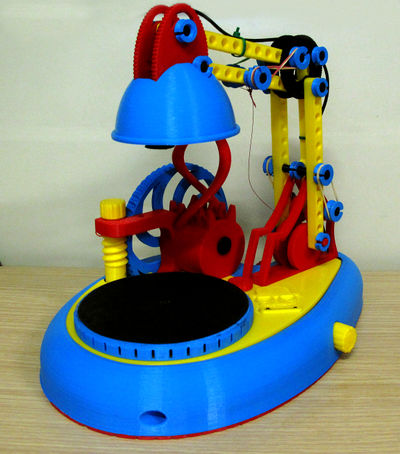Q3d
q3d is a 3D printer and a table lamp. It was created through the collaboration between Politronica srl, an Italian small enterprise, and Flying Tiger Copenhagen. Its design is inspired by the Luxo L-1 lamp, created by the Norwegian designer Jac Jacobsen in 1937.
q3d is realized according to the following pillars:
- the production of an object conceived for the retail market, completely realized through 3D fused deposition modeling (FDM) technology, and therefore with a design impossible to realize with standard technologies (e.g. plastic injection molding)
- a just-in-time production model featuring order, production and delivery in 7 days.
- a production model that is closed to the concept expressed in the Zero Marginal Cost Society, edited by Jeremy Rifkin
- q3d is under a Creative Commons Lincense
Release status: working
| Description | Photopolymer deposition
full plastic 3D printer.
|
| License | GPL
|
| Author | |
| Contributors | |
| Based-on | |
| Categories | 3D Printer
|
| CAD Models | Yes
|
| External Link | see below
|
Contents
Design
Its design is inspired by the Luxo L-1 lamp, created for the first time by the Norwegian designer Jac Jacobsen in 1937. It is from the research of George Carwardine and his Anglepoise lamp, released in 1934, that Jacobsen was inspired to design what would become the best-known architect lamp in the history of design and the mascot of the Pixar Animation Studios. The self-balancing system seems simple: though in reality it is very complex: the balance of the arm is maintained in any position by some springs that operate according to the principle of the compensatory forces exerted by the muscles of the human arm. The lamp can be positioned freely so as to allow the light source to be oriented at will. In 1937, Jacob Jacobsen presented his variant of Anglepoise by Carwardine. A table lamp called, like a modern muse, "Luxo L-1”. Finally q3d's style is inspired by the work of the American artist Alexander Calder, in particular from his alphabet composed of shapes that have been "extracted" and shaped on its plastic components (q x y z).
Capabilities
Mechanically, q3d is a composition between the Dobot printer, the Polar3D printer and the Luxo L-1 lamp. Politronica took inspiration by the Dobot for the construction of the two-joint arm, but without rotation of the base. The arm motors are not directly shafted on the segments but they act by tensioning wires. The antagonist movement is guaranteed by rubber bands that replace the springs of the Luxo. From Polar3D Politronica took the rotation of the plate but without the translation that is accomplished by the arm. q3d is fully composed by plastic parts, polylactic acid (PLA) made from corn crops. The result is a printer with an arm with two rotational degrees of freedom that guarantee a movement along the printing plate and one off the plane, movements that are the result of a conversion from Cartesian coordinates to polar coordinates. Finally, the printing plate accomplishes a circular rotation around the axis passing through its center, which guarantees the second movement along the plane. The electronic components are based on low-profile circuitry, very cheap but highly reliable, made by Arduino. The firmware is based on open source libraries, “intersecting” the Marlin “SCARA” with the “R360”.
Printable material
The real innovation is the material that is deposited by the printer and its deposition technique. Like a FDM 3D printer there is a stepper motor that pushes the viscous material towards the nozzle, but there is no hot melt. The printer extrudes a polymer resin that hardens with visible white light. For this reason when the machine does not print it can be used as a table lamp. The properties of photo-cross linkable resins have improved significantly in the last ten years: different types of materials have appeared on the market with properties optimized for specific applications and different types of 3D printing. The photocuring of these photo-active materials does not depend only on their chemical composition, but also on the irradiation power and time. The most widely used monomers are multifunctional acrylates that polymerize very quickly and can give rise to different materials by introducing chemical modifications in the precursor structure. Typically, a photo-cross linking formulation consists of two main components: a photo initiator that absorbs incident light and gives rise to two radical fragments and a monomer containing at least two unsaturated bonds, which may originate the polymeric network. Also in the last ten years, many researchers have exploited their efforts in the development of efficient photo-initiators able to generate radicals under the action of UV radiation.
These photo-initiators absorb the incident radiation which leads them to an excited electronic state from which the reactive species is produced. Therefore, a high and suitable absorption coefficient by the photo-initiator is fundamental, as well as a suitable absorption spectral range. The resins used for the most common 3D pens have been formulated with a composition free of toxic substances and, consequently, not dangerous for use by children under adult supervision.
The naturally occurring oxygen in the air impedes the chemical reaction that allows the molecules to bind to each other forming a chain of polymers. This is why the most superficial part of the resins is often thick and sticky. The resin has been formulated so as not to be sticky on the surface and to be cross-linked by irradiation of cold white light LEDs. The power chosen for irradiation is 3W, which corresponds to the most used power size in LED light bulbs for desk lamps.
The q3d can print 110x110x120 mm sized objects, created using virtual reality modeling techniques. The printing area is a cylinder with a diameter of 160 mm and height of 120 mm. It can also work in symbiosis with a special accessory that mimics the outline of the object that you want to print, which can be visualized with augmented reality techniques, whose movements are transmitted and translated into the q3d that will physically make the object.
| Specifications | |
|---|---|
| Plastic Parts | 50 |
| Non Printed Parts (approx.) | 20 |
| Cost (USD) | $99-250 |
| Controller Electronics | Arduino Mega + Ramps 1.4 / MKS Mini 2.0 |
| Printing material | Arcylic photopolymer |
| Printing Size (mm) | 110 x 110 x 120 |
| Motors | 4 x NEMA 17 Stepper |
| Frame Material | PLA |
| Frame Manufacture | 3D FDM printer |
| Pro | Easy assembly |
| Con | Not suitable for professional use |
Main innovations
The following is a list of the main innovations:
- The deposition technique, there is no hot melt since the polymer hardens with white light from a low power led source (3W)
- The photopolymer: an acrylic resin which has a viscosity similar to toothpaste
- Scara movement combined with a polar movement
- Fully 3D printed body
Electronics
Stepper Motors
The q3d uses, including the extruder, four NEMA-17 stepper motors. Two of these motors control the X and Z positions, one of them controls the rotating plate and the last controls the extrusion of the photopolymer. The stepper motors needs a minimum holding torque of 40Ncm (0.4Nm).
Controller Electronics
The q3d works perfectly using a MKS mini 2.0 or Arduino Mega/RAMPS 1.4 equipped with four stepper drivers A4988.
Extruder
The extrusion system is composed by a 1 mm nozzle, a flexible tube in polypropylene connected with the resin tube, two 1.5W white led, a mechanism "gear wheel/worm gear" that squeezes the resin tube, specially designed to raise the torque of the stepper motor by a factor of 58.
Credits
Thanks to Maurizio Mambrin, Alessandro Chiolerio, Vincenzo Guarnieri, Paolo Pandolfi, Simone Paschetto, Jessica Barolo, Marco Cotto, Paola Martino, Alessandra Rosa, Riccardo Dardano, Marcello Prisco, Mattia Palombella, Sonia Matera, Elisabetta Rosolen, Daniele Passamonte, Raffaele Spina, Pietro Giuliano, Arianna Vergani
External links
Websites
- www.q3d.it
- Politronica Inkjet Printing
- Flying Tiger Copenhagen
- reprap.org/wiki/RepRap_Machines
- Calder Foundation website
- Atelier Calder website
- National Gallery of Art – Alexander Calder
Open source files
- Thingiverse [1]
